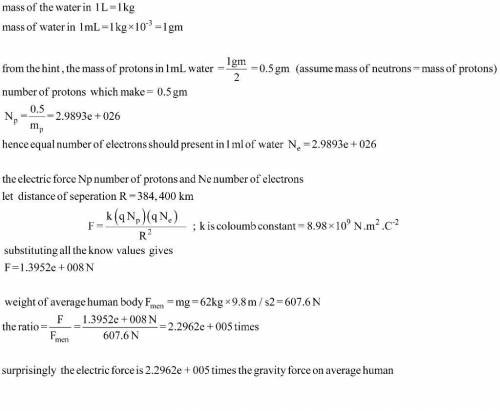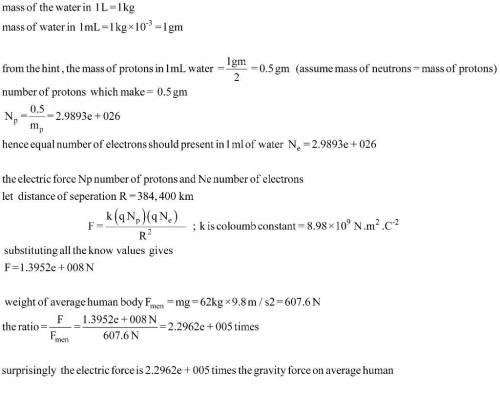
Physics, 16.04.2020 03:15 michellemonchez103
We want to get a better, more concrete idea of the strength of the electric force. So imagine you could remove all the electrons from 1 mL (1 cubic centimeter) of water. Dump the electrons on yourself, and put the electron-free nuclei (protons and neutrons) on the moon. Estimate how much force will there be between the positive and negative charges? (Of course you have to look up the earth-moon distance.) What fraction of your weight is that force? How many electrons do you have in 1 cc? Consider that virtually all the mass is given by protons and neutrons. Since the proton and the neutron have almost equal masses, and most atoms have equal numbers of protons and neutrons, so the water mass, divided by 2, is the mass of protons. Once you know the total mass of protons, divide by the mass of a single proton and you have the total number of protons. Knowing that, how many electrons do you then suppose you have?)

Answers: 3
Another question on Physics

Physics, 21.06.2019 17:20
If you were to drop a rock from a tall building, assuming that it had not yet hit the ground, and neglecting air resistance. what is its vertical displacement (in m) after 6 s?
Answers: 1

Physics, 22.06.2019 07:00
Critical mass is the of material required to produce a chain reaction. a.) minimum amount b.) atomic mass c.) precise amount d.) maximum amount
Answers: 1

Physics, 22.06.2019 08:30
Pl asaaap ! match the term to the correct description. a type of wave that transfers energy where the particles in the medium move perpendicular to the direction in which the energy is traveling. a type of wave that transfers energy where the particles in the medium move parallel to the direction in which the energy is traveling. movement that is back and forth, like an equal sign = a type of wave that transfers energy where the particles in the medium move in a circle motion while the energy travels left or right. movement that is like a t transfers energy from one location to another 1. wave 2. parallel movement 3. perpendicular movement 4. transverse wave 5. longitudinal wave 6. surface wave
Answers: 1

Physics, 22.06.2019 09:40
(a) assume the equation x = at^3 + bt describes the motion of a particular object, with x having the dimension of length and t having the dimension of time. determine the dimensions of the constants a and b. (use the following as necessary: l and t, where l is the unit of length and t is the unit of time.) (b) determine the dimensions of the derivative dx/dt = 3at^2 + b. (use the following as necessary: l and t, where l is the unit of length and t is the unit of time.)
Answers: 1
You know the right answer?
We want to get a better, more concrete idea of the strength of the electric force. So imagine you co...
Questions






Mathematics, 27.06.2019 08:20

Mathematics, 27.06.2019 08:30



Mathematics, 27.06.2019 08:30


Chemistry, 27.06.2019 08:30


Mathematics, 27.06.2019 08:30

Biology, 27.06.2019 08:30



History, 27.06.2019 08:30


Mathematics, 27.06.2019 08:30





